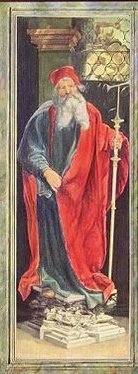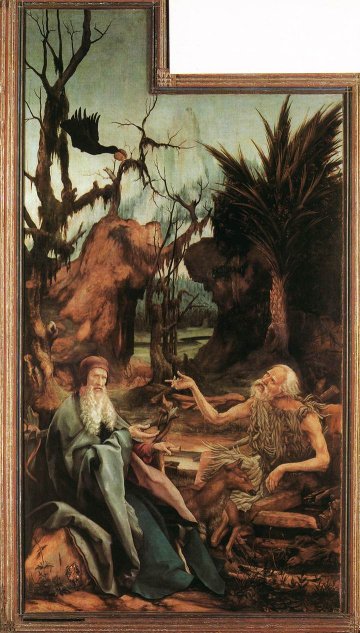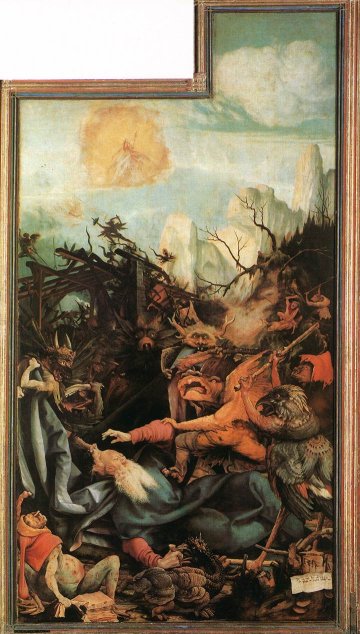|
Saint Anthony |
|
|
|
|
|
This is an extraordinary and complex artwork, and needs a study all to
itself. Here, I'm just looking at those panels which show to St.
Anthony. The altarpiece was painted for the Monastery of St Anthony in Isehheim, near Colmar. The Antonine monks there ran a hospital caring for those suffering from skin diseases and plague. Thus these two saints: Sebastian was seen as a protector against plague, and Anthony was associated with skin diseases. Why skin diseases? No-one is entirely sure. The link with pigs and pig fat (used in treating skin diseases) came later. Athanasius tells us with approval that Anthony 'neither bathed his body with water to free himself from filth, nor did he ever wash his feet nor even endure so much as to put them into water, unless compelled by necessity.' This might suggest that Anthony himself suffered from the odd itch. But this is a modern perception. A more likely reason is the description by Athenasius of some of those who brought brought to Anthony to be cured. Some of the symptoms described are similar to those of ergotism, also known as St Anthony's fire. |
|
|
|
|
|
The altarpiece had a number of configurations, depending on the liturgical needs of the moment. What is known as the third configuration had these panels. The left-hand panel showed St Anthony meeting with St. Paul - the raven with the bread is on its way. |
|
|
|
|
| The
right-hand panel is horrific, and one might think it is hardly
appropriate for those suffering from skin diseases. Again, this is a
modern perception. The unfortunate sufferer in the bottom left shares
Anthony's suffering, but only look up and help is at hand: Nor was the Lord then forgetful of Anthony's wrestling, but was at hand to help him. So looking up he saw the roof as it were opened, and a ray of light descending to him. The demons suddenly vanished, the pain of his body straightway ceased, and the building was again whole. But Anthony feeling the help, and getting his breath again, and being freed from pain, besought the vision which had appeared to him, saying, “Where wert thou? Why didst thou not appear at the beginning to make my pains to cease?” And a voice came to him, “Anthony, I was here, but I waited to see thy fight; wherefore since thou hast endured, and hast not been worsted, I will ever be a succour to thee, and will make thy name known everywhere.” Having heard this, Anthony arose and prayed, and received such strength that he perceived that he had more power in his body than formerly. (Athanasius chapter 10). So the message of the altarpiece is: your suffering is part of God's purpose, but in the end, with faith, relief will come. Note: There is a good article on the Antonine Order on Wikipedia, here: http://en.wikipedia.org/wiki/Hospital_Brothers_of_St._Anthony |
|
|
|
|



